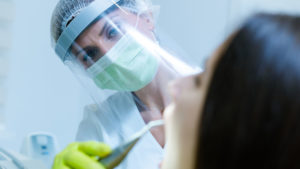18 Oct Fewer Than 1 Percent of Dentists Contracting COVID
 Contrary to previous assumptions in spring 2020, fewer than 1 percent of dentists nationwide were found to be COVID-19 positive, according to a report in the U.S. based on data collected in June 2020. In addition, the result is far below that of other health professionals in the U.S.
Contrary to previous assumptions in spring 2020, fewer than 1 percent of dentists nationwide were found to be COVID-19 positive, according to a report in the U.S. based on data collected in June 2020. In addition, the result is far below that of other health professionals in the U.S.
The report, published by The Journal of the American Dental Association, is the first large-scale collection and publication of U.S. dentists’ infection rates and infection control practices related to COVID-19. “This is very good news for dentists and patients,” said ADA Science and Research Institute Chief Executive Officer Marcelo Araujo, D.D.S., M.S., Ph.D., the senior author of the report. “This means that what dentists are doing – heightened infection control and increased attention to patient and dental team safety – is working.”
This report focused on nearly 2,200 dentists in June, finding that 82 percent of dentists were asymptomatic for one month prior to the survey and 16.6 percent reported getting a COVID-19 test. Those who tested positive were not clustered in any particular geographic region. Among those not tested, less than 1 percent (0.32) were given a probable COVID-19 diagnosis by a physician. The authors weighted the results to align with U.S. dentists demographically and geographically and found an estimated prevalence of less than one percent (0.9) with a margin of error of 0.5 percent.
In March, The New York Times listed dentistry as one of the professions at highest risk of COVID-19 based on data from O*NET, a database maintained by the U.S. Department of Labor. It was presumed that virus transmission could occur because of the close proximity between dental professionals and patients and because many dental procedures generate aerosols that may contain viral particles from infected individuals. This newly-published report, with the extremely low rate of COVID-19 infection among dentists, supports the effectiveness of the recommendations from the CDC and ADA in preventing virus transmission. The ADA’s guidance calls for the highest level of personal protective equipment (PPE) available—masks, goggles and face shields. The ADA’s interim guidance also calls for the use of rubber dams and high velocity suction whenever possible and hand scaling when cleaning teeth rather than using ultrasonic scaling to minimize aerosols.
Read more:
- NBC: As dentists reopened in late spring, very few got Covid-19, survey finds
- Fox News: Coronavirus infected less than 1% of dentists nationwide, study suggests
- Healthline: Dentists Are Reporting a Low Rate of COVID-19: Here’s Why


Sorry, the comment form is closed at this time.